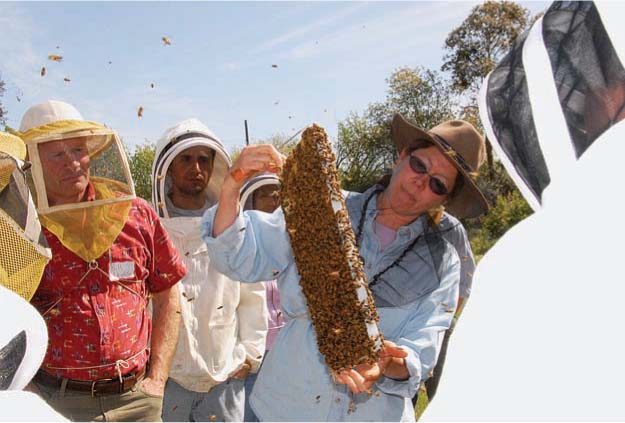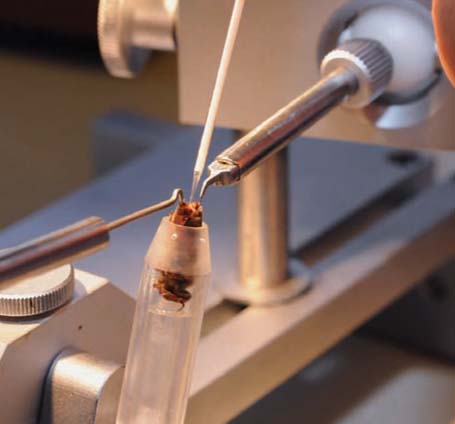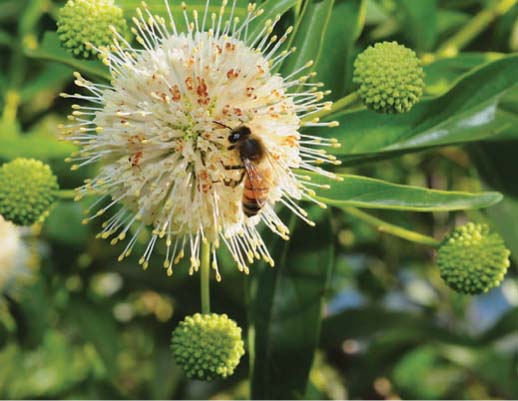All Issues
Genetics and breeding help build a better, stronger bee
Publication Information
California Agriculture 63(3):111-112.
Published July 01, 2009
PDF | Citation | Permissions
Full text
Susan Cobey, a bee breeder-geneticist at UC Davis, is out to build a better bee lock, stock and beehive. "With the increasing challenges of beekeeping today, the selection of honey bee stocks that are productive, gentle and show some resistance to pests and diseases is critical to the future health of the beekeeping industry, agriculture and our food supply," says Cobey, an international authority on queen-bee rearing and instrumental insemination.
Developed in the 1920s and perfected in the 1940s and 1950s, instrumental insemination provides "a method of complete control of honey bee mating," Cobey says. Cobey, manager of the Harry H. Laidlaw Jr. Honey Bee Research Facility, trained under the late Laidlaw (1907-2003), considered the father of honey bee genetics.
Her current work involves increasing genetic diversity in the general bee population and more specifically in her New World Carniolan closed breeding population, which she established in 1981.
"Major advances in agriculture are due to stock improvement and this also applies to honey bees," Cobey says. In nature, a queen bee mates with 10 to 20 drones in flight over several days and returns to her hive to lay eggs for the rest of her life. During her 2-to-3-year life span, the queen will lay approximately 1,000 eggs a day, and as many as 2,000 a day in peak season.
"Instrumental insemination allows bee breeders and geneticists to make specific crosses," Cobey says. "The closed-population breeding system can enhance the frequency of desirable traits."
Another advantage is the ability to store and ship honey bee semen. "This minimizes the risk of spreading pests and diseases," says Cobey, who this year helped develop a protocol for the international importation of honey bee germplasm.
Since the early 1980s, Cobey has taught specialized classes in queen rearing and instrumental insemination, drawing researchers and beekeepers from South America, Europe, Asia and Africa.
The UC Davis bee geneticist works closely with the state, national and global beekeeping industry, including the California Bee Breeders, who produce half the nation's supply of mated queen honey bees. To improve stock, Cobey imports bee semen from Germany and Italy. With the German stock, she is selecting for traits of resistance to varroa mites. One cross has increased expression for hygienic behavior "and so far they look very productive," she says.
Understanding colony collapse disorder
Cobey's New World Carniolan bees are known for their high productivity, rapid spring buildup, overwintering ability, resistance to diseases and gentle temperament. "Sue's bees are polite," says Eric Mussen, UC Cooperative Extension apiculturist.
"California agriculture depends upon a healthy and viable beekeeping industry," he says. The value of California crops pollinated by bees exceeds $6 billion; bees pollinate some 100 crops in California, Mussen says, including about 700,000 acres of almonds, mostly grown in the Sacramento and San Joaquin valleys.
Improving bee stock can result in a bee that is more resistant to pests, pathogens and parasites, considered key factors in colony collapse disorder (CCD), "a mysterious malady that has killed colonies of honey bees in practically every state across the country, including California," he says.
Honey bee colonies began dying of what is now called colony collapse disorder in fall 2004. However, massive bee die-offs are not a new occurrence, Mussen says, and were documented under various names in 1869, 1963, 1964, 1965 and 1975.
Mussen says the die-offs may be caused by a combination of factors such as pesticides, diseases, malnutrition and stress. When the disorder strikes, nearly every adult bee leaves the hive over a period of just a few days, leaving behind the queen, various stages of brood (eggs, larvae, pupae) and stores of edible honey and pollen.
"Recently abandoned combs will kill another colony placed on them," Mussen says. However, drying, irradiating or fumigating the combs with glacial acetic acid allows a subsequent colony to use the combs safely. "This suggests a role for one or more microbial pathogens, but researchers have been unable to detect novel microbes."
Colony collapse disorder has decimated commercial bee colonies, as well as some colonies kept by hobby and organic beekeepers. However, Mussen says that urban beekeepers have three distinct advantages that tend to reduce their problems with colony collapse disorder. "First, they tend to be spatially isolated from commercial colonies that can readily share maladies. Second, urban colonies often have access to large numbers of annual and perennial plants. Mixed pollens provide the building blocks for the best bee diets and most robust bees."
"The third critical difference appears to be that local populations of honey bees and the parasitic mite, Varroa destructor, seem to develop an equilibrium that allows the colonies to survive without harsh chemical treatments," Mussen says. "Those regional groups of beekeepers are purposely interbreeding their survivor bees and colony losses tend to be minimal."
Honey bee haven to encourage bee-friendly gardening
Plans for the Haagen-Dazs Honey Bee Haven, a half-acre bee-friendly garden on Bee Biology Road, are buzzing right along.
The haven near the Harry H. Laidlaw Jr. Honey Bee Research Facility at UC Davis will offer a year-around food source for the bees and other insects, raise public awareness about the plight of honey bees, and encourage visitors to plant gardens that are friendly to honey bees and a range of native bee species (see page 113).
"The winning design fits beautifully with the campus mission of education and outreach, and it will tremendously benefit our honey bees," says Lynn Kimsey, UC Davis entomology professor and director of the Bohart Museum of Entomology. Bee-friendly plants in the garden will include lavender, salvia (sage), catmint, California buckwheat, toyon, blad-derpod and tower of jewels.
The haven, a $125,000 gift from the premium ice cream brand (which is produced by Dreyer's Grand Ice Cream of Oakland), will spring to life in late September and be dedicated in October. A Sausalito-based team submitted the winning design in an internationally publicized contest.
"We'll not only be providing a pollen and nectar source for millions of bees, but we will also be demonstrating the beauty and value of pollinator gardens," says Melissa Borel, program manager for the California Center for Urban Horticulture, which coordinated the competition.
In February 2008, Haagen-Dazs pledged $250,000 for honey bee research, shared by UC Davis and Pennsylvania State University; a second $250,000 donation was added in 2009. (The company depends on bee pollination for 50 ice cream flavors.)
Site already teeming with native bees
Native pollinator specialist Robbin Thorp, UC Davis emeritus entomology professor, is monitoring the level of insect activity at the plot where the garden will be constructed. He began establishing baseline data in March, and is also gathering data on honey bee flower visitation, especially their pollen resources.
From just two sample days (March 20 and April 19), Thorp found a total of 27 species of bees. "Most are solitary, ground-nesting, native bee species," Thorp says. He also found that honey bees collected pollen from four of six plant species they visited.
"Currently all the bees are relying on a low diversity of weedy flowering plants in the area and planted trees such as almond, eucalyptus and walnut," he says.
"I expect these numbers in diversity and abundance to continue to increase as the garden matures and more bees discover a long-term, stable, food resource base. I also expect resource use by honey bees and other bees to expand as new resources become available in the garden."
Kathy Keatley Garvey
For more information:
UC Davis bee garden:
http://entomology.ucdavis.edu/news/honeybeehavenwinner.html
Haagen-Dazs -Help the Honey Bees







